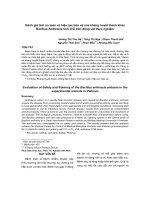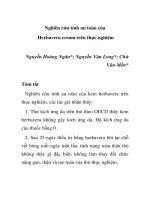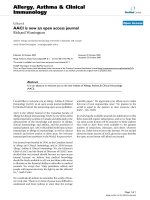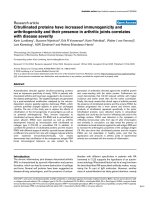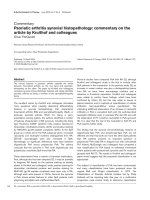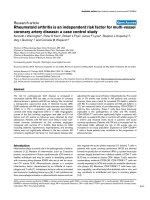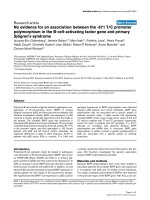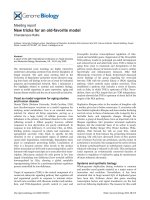Báo cáo y học: "Armed conflicts have an impact on the spread of tuberculosis: the case of the Somali Regional State of Ethiopia" pptx
Bạn đang xem bản rút gọn của tài liệu. Xem và tải ngay bản đầy đủ của tài liệu tại đây (352.79 KB, 6 trang )
RESEARC H Open Access
Armed conflicts have an impact on the spread of
tuberculosis: the case of the Somali Regional
State of Ethiopia
Abdi A Gele
1,2*
, Gunnar A Bjune
2
Abstract: A pessimistic view of the impact of armed conflicts on the control of infectious diseases has generated
great interest in the role of conflicts on the global TB epidemic. Nowhere in the world is such interest more
palpable than in the Horn of Africa Region, comprising Ethiopia, Somalia, Eritrea, Djibouti, Kenya and Sudan. An
expanding literature has demonstrated that armed conflicts stall disease control programs through dis traction of
health system, interruption of patients’ ability to seek heal th care, and the diversion of economic resources to
military ends rather than health needs. Nonetheless, until very recently, no research has been done to address the
impact of armed conflict on TB epidemics in the Somali Regional State (SRS) of Ethiopia.
Methods: This study is based on the cross-sectional data collected in 2007, utilizing structured questionnaires
filled-out by a sample of 226 TB patients in the SRS of Ethiopia. Data was obtained on the delay patients
experienced in receiving a diagnosis of TB, on the biomedical knowledge of TB that patients had, and the level of
self-treatment by patients. The outcome variables in this study are the delay in the diagnosis of TB experienced by
patients, and extent of self- treatment utilized by patients. Our main explanatory variable was place of residence,
which was dichotomized as being in ‘conflict zones’ and in ‘non-conflict zones’. Demographic data was collected
for statistical control. Chi-square and Mann-Whitney tests were used on calculations of group differences. Logistic
regression analysis was used to determine the association between outcome and predictor variables.
Results: Two hundred and twenty six TB patients were interviewed . The median delay in the diagnosis of TB was
120 days and 60 days for patients from conflict zones and from non-conflict zones, respectively. Moreover, 74% of
the patients residing in conflict zones undertook self-treatment prior to their diagnosis. The corresponding
proportion from non-conflict zones was 45%. Fully adjusted logistic regression analysis sho ws that patients from
conflict zones had significantly greater odds of delay (OR = 3.06; 95% CI: 1.47-6.36) and higher self treatment
utilization (OR = 3.34; 95% CI: 1.56-7.12) compared to those from non-conflict zones.
Conclusion: Patients from conflict zones have a longer delay in receiving a diagnosis of TB and have higher levels
of self treatment utilization. This suggests that access to TB care should be improved by the expansion of user
friendly directly observed therapy short-course (DOTS) in the conflict zones of the region.
Background
Tuberculosis is a major public health problem in the
world and the problem is particularly widespread in
sub-Saharan Africa [1]. More than 80% of the people
suffering from TB live in sub-Saharan Africa or in Asia
[2], where spending on health care is low and access to
drugs is limited. Although good TB programs in parts
of Africa had an appreciable impact in the reduction of
TB cases, military conflicts and civil strife in some coun-
tries play a major role in stalling TB control programs
[3]. Many people die each year of TB in those parts of
the world because various forms of war and low spend-
ing on health care deprive them of access to treatment
[4]. Against this backdrop of neglect, it is little wonder
that TB has been allowed to spread. Nonetheless, there
is a lack of information on the impact of longstanding
armed conflict in the SRS on TB epidemics in Ethiopia.
More than 191 million people lost their lives in the 20
th
century due to armed conflicts [5]. Tuberculosis is known
* Correspondence:
1
Department of Social Science, Oslo University College, Oslo, Norway
Gele and Bjune Conflict and Health 2010, 4:1
/>© 2010 Gele and Bjune; licensee BioMed Central Ltd. This is an Open Access article distributed under the terms of t he Creative
Commons Attribution License ( which permits unrestricte d use, distribution, and
reproduction in any medium, provided the original work is properly cited.
to be a major cause of morbidity and mortality in conflict
settings [6-9]. When one combatant dies in the conflict,
an additional 14 to 15 civilians die, mostly from preventa-
ble infectious diseases such as TB [10]. Conditions of war
were associated with the rapid increase of morbidity and
mortality from TB [7]. A review of the literature reported
an increase in the incidence of TB during war years and
excessive morbidity and mortality many years after the
war [7]. For example, the TB mortality rate in Holland
rose from 154 per 100,000 in 1915, to 180 per 100,000 in
1916, while the TB mortality rate increased by 50% in Ber-
lin from 1916 to 1917 [6]. A prior study conducted in
Nepal reported poor utilization of TB treatment and diag-
nostic services among war affected populations. This was
mainly due to massive military campaigns, frequent cur-
fews, and closures of services in conflict areas, and subse-
quently, to an increase in the prevalence of TB in the
population [9].
Ethiopia ranks 7
th
of the 22 countries with highest TB
burden in the world [11]. The Somali Regio nal State of
Ethiopia is an area suffering from a long running conflict.
The conflict has severely undermined the ability of the
public sector to deliver basic social services to most of its
population. As a result, people in the region are not only
exceedingly poor [12], but also bear a disproportionately
highincidenceofTB.Intheyear2000,theincidenceof
pulmonary positive TB in the Somali Regional State of
Ethiopia was noted at 175-250/100,000, which is much
higher than the national level of 165/100,000 [13].
The population in the region overwhelmingly consists
of Somali pastoral nomads; a migratory people whose
livelihood is primarily based upon rearing livestock.
These people migrate seasonally or episo dically in search
of grazing lands and water. Despite significant TB-related
morbidity a nd mortality amongst the nomads of this
region, the disease has been largely neglec ted [14]. We
conducted a broad-based study that addressed socio-cul-
tural attributes in the management and control of TB
among Somali nomads in the SRS of Ethiopia from July
to Septem ber 2007. As a part of this study, we documen-
ted the length of delay in receiving a diagnosis of TB that
patients reported [14] and the barriers to TB care t hat
they perce ived (under publication). In this paper, we
intend to examine the role of conflict in a regional TB
epidemic by comparing patients from conflict zones in
the region to patients from non-conflict zones with
regard to the delay they experienced in the diagnosis of
TB and the extent to which these patients utilized self
treatments before the diagnosis of TB was made.
Study area
The SRS is the second largest among the nine regions of
Ethiopia, with a land area of 375,000 km
2
and an esti-
mated population of 4 million people. Three different
systems of livelihood exist in the SRS: these are; pastor-
alism, agro-pastoralism and urban [12]. An estimated
85% of regional populations earn their livelihoods from
pastoralism or agro-pastoralism.
The Regional TB control program adopted the DOTS
strategy, which is implemented through DOT clinics
that are located in major towns. The private sector is
very rare in the Somali Regional State of Ethiopia.
Neither the private sector nor traditional healers are
involved in the regional TB control program.
The region is characterized by longstanding conflict
between government forces and local armed rebel
forces, i.e., the Ogaden National Liberation Front
(ONLF). Although the conflict had been simmering for
years, new momentum occurred in early 2007 [15]. The
SRS consists of 9 zones. However, most of the battles
and war activities are concentrated in 5 zones, i.e., Dha-
gaxbur, Fiiq, Korahe, Gode and Wardheer. All of these 5
zones are overwhelmingly populated by pastoral nomads
[15,16]. As a result, the no madic populations are faced
with restrictions of movement that prevent them from
fully utilizing their traditional survival mechanisms and
their access to health care [17]. Medecins Sans Fron-
tieres (MSF) provides health services, including TB care
tothepeoplewholiveinthefiveconflictzones.How-
ever, the Ethiopian government denied MSF access to
these zones from April 2007 [18]. This study was con-
ducted from June - September 2007, in the Jigjiga and
Shinile zones of the SRS of Ethiopia.
Methods
An institution based, cross sectional study was carried
out in the SRS of Ethiopia. The study population was
selected from the TB management units in the J igjiga
and Shinile zones of the SRS. The selection of the study
sites was based upon security and accessibility, i.e. t he
existence of roads that could b e safely traveled. More-
over, about 50% of the diagnostic facilities in the SRS are
found within these two zones (figure 1). As a conse-
quence, pastoral nomads from other zones in the region
come to these facilities for the diagnosis and treatment of
TB. The respondents were illiterate and unable to read
consent forms. As a consequence, witnesse d consent was
obtained from patients. The study was approved by the
Regional Committee for medical Research Ethics.
We calculated the sample size using the formula
necessary for determination of sample size required for
estimating single proportion. By using previous study on
patient delay in the diagnosis of pulmonary TB in Ethio-
pia which obtained a proportion delay of 82% of more
than one month [19] with 95% confidence interval and
margin of error of 5%, we found a sample size of 226.
Pre-tested structured questionnaires were consecutively
administered to 226 patients, all of whom were
Gele and Bjune Conflict and Health 2010, 4:1
/>Page 2 of 6
pastoralists who had been in the intensive phase of TB
treatment from June to September 2007. Patients over
15 years of age, w ho gave their informed consent, were
included in the study.
The outcome variable was delay in the diagnosis of TB;
referring to a period from th e o nset of clinical symptoms
of TB to the first visit to a professional health care provi-
der. Patients were asked about major symptoms of TB, the
length of time that they suffered from these major symp-
toms and the date when they first visited a professional
health care provider. Along wit h the questionnair e-based
interviews, we simultaneously cross-checked the out-
patient cards of respondents, their patient registration
cards, laboratory registrations and TB registration books.
The second outcome variable was ‘self-treatment’ prior to
a biomedical diagnosis. The main predictor variable was
area of residence at the onset of major TB symptoms. This
was dichotomized as being in ‘conflict zones’ or in ‘non-
conflict zones’. Moreover, we collected socio-demographic
variables for statistical control, including age, gender,
means of livelihood, and the distance to a health facility.
Analysis
The median of the observed data (60 days) was used as
a cut off point for short and long delay in diagnosis of
TB [14,19,20]. Frequencies were used to summarize
data concerning the diff erent individual characteristics
of respondents. Group differences were calculated
using Chi-square and Man n-Whitney test. If groups
were more than two, we employed Kruskal-Wallis t est.
These statistical methods were employed because they
are appropriate for a nalysis of categorical variables.
Afterwards, logistic regression analysis was performed
to assess the associations between outcome variables
and the predictor variable. Odd ratios (OR) and 95%
confidence intervals (CI) were obtained from each vari-
able. P-value <0.05 was considered statistically
significant.
Results
Two hundred and twenty six TB patients were inter-
viewed from June to September 2007. Among them, 172
(76%) were from non-conflict zones of the region , while
54 patients (24%) were from conflict zones. Socio-demo-
graphic characteristics in relation to patients’ area of
residence a re shown in Table 1. The pro portion of
women and men were 45.1% and 54.9%, respectively.
The average age of the study population was 32.2 years
(SD ± 13.0 years). The vast majority of the respondents
in this study population (200, 88.5%) were illiterate.
There was no difference between the two groups with
regard to soc io-demographics such as gender, age, mari-
tal status, occupation and education. However, a higher
proportion of patients from conflict zones (63%) were
pastoral nomads and the remaining proportion (37%)
gained their livelihoods by combining agriculture and
pastoralism. The vast majo rity of study participants
believed that TB is caused by malnutrition (78%) and by
overworking (79%). Only 27% knew that TB is an infec-
tious disease that is caused by bacteria.
Figure 1 The distribution of tuberculosis diagnostic centers in the 9 zones of the SRS of Ethiopia. - Black dots represent diagnostic
centers. - Colored areas represent 5 conflict zones, while shadowed areas represent non conflict zones. - Arrow points to the zones studied in
this research project.
Gele and Bjune Conflict and Health 2010, 4:1
/>Page 3 of 6
Two hundred and six patients (91%) reported that
they consume raw milk, while 89% have never heard
that the consumption of raw milk can cause the trans-
mission of TB from cattle to man.
The med ian d elay in di agnosis of 120 days w as
recorded for patients from conflict zones, which was
twice as high as the median delay recorded for patients
from non-conflict zones (60 days). This difference was
significant (Mann-Whitney test, P < 0.001). For patients
from confl ict zones, 74% undertook self-treatment prior
to diagnosis, while the corresponding proportion of
patients undertaking self-treatment in non-conflict
zones was 45%. This difference was also si gnificant
(Chi-square test, P < 0.001).
The crude logistic regression analysis (table 2) shows
that pastoral nomads from conflict zones had signifi-
cantly greater odds of delay (OR = 4.3; 95% CI: 2.22-
8.38) than those from non-conflict zones. This signifi-
cant difference in delay between the two groups per-
sisted (OR = 3.06; 95% CI: 1.47-6.36) ev en when
adj ustments were made for age, gender, livelihood cate-
gory and distance to health facilities. Similarly, a fully
adjusted regression model shows that pastoral nomads
from conflict zones had more than 3 times higher odds
of undertaking self-treatment prior to diagnosis (OR =
3.34, 95% CI: 1.56-7.12) than their corresponding group.
Discussion
The large n umbers of armed conflicts in Africa may
impact TB control programs, because armed conflicts
interfere with the goals of identifying and curing TB
patients [21]. This study reports over 3 times higher
odds of delay in the diagnosis of TB for patients from
conflict zones of the Somalia Regional State of Ethiopia,
when compared to their counterparts from non-conflict
zones. Delay in the diagnosis of TB patients has been
associated with increased transmission of the disease
[22]. Furthermore, conflicts and the resultant restricted
access to health services, is known to exacerbate the
incidence of tuberculosis [23]. Armed conflicts may not
only fuel TB epidemics by escalating poverty and mal-
nutrition, and thereby increase the number of TB sus-
ceptible individuals, but such conflicts may also deter
infectious TB patients from seeking prompt diagnosis
and treatment. This will lengthen the duration o f the
infectious period and thus increase the pool of infec-
tions within communities. Scenarios of this kind were
experienced during the war in Iraq, where the number
of new TB cases nearly tripled as the war impoverished
people, destroyed health infrastructures and interr upted
access to anti-TB treatment [24]. A four-fold increase of
TB incidence has also been recorded in Bosnia and
Herzegovina since the beginning of the war in 1991
[25]. Increased rates of a ctive TB has been associated
with conditions of war in a number of reports [26]. In
Ethiopia, over a third of the population is exposed to
TB and more than 120,000 new cases were reported in
the year 2004 alone [27]. Unless action is taken to
improve the access to TB diagnosis and treatment, the
World Health Organization (WHO) predicts that the
number of active TB cases in parts of sub-S aharan
Africa will double within 10 years [28]. This is very
likely in countries such as Ethiopia, where the vast
majority of its people have no access to TB care [29].
As shown in figure 1, there are only 4 diagnostic cen-
ters in conflict zones of the Somalia Regional State; an
area in which more than 2 million peopl e are inhabi-
tants, obliging TB patients to walk for more than 100
kilometers to access TB care. As health care needs
increase in conflict settings, access to health care is
often limited by poverty and by the lack of security
[30]. This is reflected by extremely long patient delay
(median, 120 days) recorded for patients in conflict
zones of the Somalia Regional State of Ethiopia. The
median delay of 120 days in the diagnosis of TB greatly
contrasts with the delay in diagnosis recorded for TB
patients from non-conflict zones in the same region (60
days), as well as the recorded delays for patients in
other peaceful regions of the country, such as Addis
Ababa (60 days) [31], the Amhara region (30 days) [19],
the Southern Nations region (30 days) [32] and the
Tigre region (30 days) [33]. The finding in this study is
consistent with other findings that armed conflicts are a
source of diagnostic delay, because they prevent patients
from seeking prompt TB care [34].
Table 1 Demographic characteristics of study population
in relation to patients’ area of residence (conflict vs non-
conflict zones)
Characteristics From conflict zones From non-conflict zones
No % No %
Sex
Female 24 44.4 78 45.3
Male 30 55.6 94 54.7
Age
≤ 25 17 31.5 70 40.7
26-45 24 44.4 80 46.5
≥ 46 13 24.1 22 12.8
Education
Illiterate 49 90.7 151 87.8
Literate 5 9.3 21 12.2
Marital status
Married 35 64.8 94 54.7
Single 14 25.9 65 37.8
Widowed/Divorced 5 9.3 13 7.6
Form of TB
Pulmonary 36 66.7 139 80.8
Extra-pulmonary 18 33.3 33 19.2
Gele and Bjune Conflict and Health 2010, 4:1
/>Page 4 of 6
The 1978 Alma Ata Declaration stated that access to
health care for all is a human right, and its violation has
been described as being unacceptable, when the causes
for that violation are unjust, avoidable and unnecessary
[35]. We believe that the armed conflict in the Somalia
Regional State of Ethiopia is an avoidable factor that
substantially contributes to TB epidemics in Ethiopia.
Since there is an imminent danger that conflict zones in
Ethiopia may be a breeding ground for TB in that coun-
try, international organizations and national authorities
should establish p rograms that are specifically ear-
marked for the prompt diagnosis and treatment of TB
for those people who i nhabit areas where armed con-
flicts continue to be waged.
Ourstudyshowsthatpatientsfromconflictzones
have significantly higher odds of undertaking self treat-
ment (OR = 3.34, 95% CI: 1.56-7.12) compared to
patients from non-conflict zones. A previous study
shows that 87% of the pastoral nomads who were TB
patients in the SRS of Ethiopia sought traditional (ani-
mist) health care for their illness prior to diagnosis
[14]. For people who have little exposure to modern
medical care, an appeal to traditional healers may be
the only option. A significant association between self-
treatment and long delay in the diagnosis of TB was
documented in Ethiopia [19,36]. Moreover, self-treat-
ment was also associated with increased morbidity and
death from TB [37]. Armed conflicts hamper TB con-
trol efforts not only by disrupting the health system
but by diverting economic resources to priorities other
than health needs [38]. When national priorities shift
and attention is deflected, TB control efforts may suf-
fer [39]. The most cited reason for the increase in TB
epidemics in Ethiopia is a lack of sufficient funds for
TB control programs [40]. Although underfunding
makes the provision of effective intervention difficult
[41], sustainable political commitment for the diagno-
sis and treatment of TB is a fundamental condition for
the implementation of successful TB control programs
[41]. Being mindful of this, we advocate initiatives that
will generate and sustain the effective political will
needed to insure that effective TB control will be
implemented in the SRS of Ethiopia.
The present study has several potential limitations.
Since this was a cross-sectional study, we are unable to
determine cause-and-effect relationships. Our outcome
variables were necessarily self-reported, and these
reports may suffer from recall bias.
Conclusion
Patients from conflict zones of the SRS of Ethiopia
have significantly higher delay in the diagnosis of TB
and higher levels of self-treatment prior to diagnosis
than patients from non-conflict zones. However, the
early diagnosis and treatment of TB patients is possible
in conflict settings [42]. This can be achieved by the
promotion of peace, by the expansion of user friendly
DOTS in conflict zones and by empowering the local
Table 2 Associations between delay in the diagnosis of TB, self-treatment prior to diagnosis, and being an inhabitant
of a conflict zone
Delay in diagnosis Self treatment
Variables Module1 crude Module 2 adjusted Module1 Crude Module2 adjusted
OR (95% CI) OR (95% CI) OR (95% CI) OR (95% CI)
Zone of residence
Non-conflict Zones 1.00 1.00 1.00 1.00
Conflict Zone 4.32 (2.22-8.38) 3.06 (1.47-6.36) 3.28 (1.66-6.47) 3.34 (1.56-7.12)
Gender
Male 1.00 1.00
Female 1.16(0.65-2.06) 0.61(0.35-1.06)
Age
0-25 1.00 1.00
26-45 0.48(0.26-0.91) 0.63(0.35-1.13)
46+ 1.32(0.47-3.69) 0.61(0.23-1.65)
Pastoralist status
Agro-pastoralist 1.00 1.00
Nomadic -pastoralist 2.33(1.28-4.24) 0.81(0.45-1.46)
Distance to health facility
<10 km 1.00 1.00
>10 km 1.30(0.65-2.62) 1.32(0.69-2.53)
Module 1: Only the predictor variable was included in the logistic regression model.
Module 2: Potential confounders were added in the model.
Gele and Bjune Conflict and Health 2010, 4:1
/>Page 5 of 6
community. Local communities need training programs
to qualify community health workers for the early
detection of TB suspects, and for the distribution and
observation of treatment. Moreover, international orga-
nizations that provide health services, such as TB care,
should be given unconditional access to conflict zones
so that peo ple who are affected by the conflict are pro-
vided with TB care that is within their reach.
Acknowledgements
We would like to thank Sissel Seim, Ivan Harsløf and Larry Young, all of
whom are employed by Oslo University College, for their valuable inputs
and help with this manuscript. We also want to thank Jiijo D. Dhimbil,
Hamsa Abdikadir, Sumaya Ali and the staff of the Regional Health Bureau of
the Somalia Regional State of Ethiopia for the support they provided during
the field work phase of this research. The field work part of this study was
financially supported by the Norwegian Program for Development, Research
and Education (NUFU) (Project number NUFUPRO. 2007\10198). Preceding
Author details
1
Department of Social Science, Oslo University College, Oslo, Norway.
2
Section for International Health, Department of General Practice and
Community Medicine, University of Oslo, Oslo, Norway.
Authors’ contributions
AG: Did data collection, data analysis and drafted the manuscript. GB: Was
involved in data collection, data analysis and in writing the manuscript. All
authors read and approved the final version of the manuscript.
Competing interests
The authors declare that they have no competing interests.
Received: 5 November 2009
Accepted: 28 January 2010 Published: 28 January 2010
References
1. WHO: Strategic Plan for Tuberculosis Control for the African Region:
2006-2010. Geneva, World Health Organization 2007.
2. WHO: Global tuberculosis control: surveillance, planning, financing. 2006.
3. Waldman RJ: Public health in times of war and famine: what can be
done? What should be done?. JAMA 2001, 286(5):588-90.
4. Smallman-Raynor MR, Cliff AD: War epidemics: A historical geography of
infectious diseases in military conflict and civil strife. Oxford University
Press Inc; New York 2004.
5. WHO: World Report on Violence and Health. World Health Organization:
Geneva 2002.
6. Armstrong DB: Civilian tuberculosis control following war conditions. The
American Journal of Public Health 1918, 897-904.
7. Barr RG, Menzies R: The effect of war on tuberculosis. Results of a
tuberculin survey among displaced persons in El Salvador and a review
of the literature. Tuber Lung Dis 1994, 75(4):251-9.
8. Coninx R: Tuberculosis in complex emergencies. Bulletin of the World
Health Organization 2007, 85(8):569-648.
9. Tiwari SK, Sitthi-ammorn C, Wang JL, Kasetjaroen Y, Love EJ: Prevalence of
TB and service utilization in conflict affected areas of Nebal. Journal of
Nebal Health Research Counsil 2005, 3(1):45-57.
10. MacQueen G, Santa-Barbara J: Peace building through health initiatives.
BMJ 2000, 321(7256):293-6.
11. Omoigui AN: Public Health Implications of conflicts in Africa. 2006.
12. Devereux S: Vulnerable Livelihoods in Somali Region, Ethiopia. 2006.
13. Dualeh WM: Health Services for the drought-affected populations in the
Somali National Regional State (Gode, Denan and Jijiga). 2000.
14. Gele AA, Bjune G, Abebe F: Pastoralism and delay in diagnosis of TB in
Ethiopia. BMC Public Health 2009, 9:5.
15. Human Rights Watch: Collective punishment: War Crimes and Crimes
against Humanity in the Ogaden area of Ethiopia’s Somali Regional
State. 2008.
16. United Nations Office for Coordination of Humaniterian Affiars: Somali
Region update. Humanitarian Bulletin 2008.
17. Doctors Without Borders: Obstructions Lead MSF-Switzerland to
Withdraw from FIIQ, Somali Region of Ethiopia. 2008.
18. Healy S: Conflict in the Ogaden and its Regional dimensions. Chatham
House: Center of African Studies 2007.
19. Yimer S, Bjune G, Alene G: Diagnostic and treatment delay among
pulmonary tuberculosis patients in Ethiopia: a cross sectional study. BMC
Infect Dis 2005, 5
:112.
20. Cambanis A, Ramsay A, Yassin MA, Cuevas LE: Duration and associated
factors of patient delay during tuberculosis screening in rural Cameroon.
Trop Med Int Health 2007, 12(11):1309-14.
21. Coninx R: Tuberculosis in complex emergencies. Bull World Health Organ
2007, 85(8):637-40.
22. Madebo T, Lindtjorn B: Delay in Treatment of Pulmonary Tuberculosis: An
Analysis of Symptom Duration Among Ethiopian Patients. Med Gen Med
1999, E6.
23. Agutu WO: Short-course tuberculosis chemotherapy in rural Somalia. East
Afr Med J 1997, 74(6):348-52.
24. Kreisel W: Health situation in Iraq. 2001 />sanctions/ep_hearing_who.pdf.
25. Barr RG, Menzies R: The effect of war on tuberculosis. Tubercle Lung Dis
1994, 75:251-9.
26. Toole MJ, Galson S, Brady W: Are war and public health compatible?.
Lancet 1993, 341:1193-6.
27. The Earth Institute at Columbia University CfNHDiE. Tuberculosis
2006 />28. Davey S: New global plan to halt TB. Bull World Health Organ 2001,
79(12):1172-3.
29. USAID: Tuberculosis profile of Ethiopia. 2009.
30. Ponsar F, Ford N, Van HM, Mancini S, Bachy C: Mortality, violence and
access to care in two districts of Port-au-Prince, Haiti. Confl Health 2009,
3:4.
31. Demissie M, Lindtjorn B, Berhane Y: Patient and health service delay in
the diagnosis of pulmonary tuberculosis in Ethiopia. BMC Public Health
2002, 2:23.
32. Cambanis A, Yassin MA, Ramsay A, Bertel SS, Arbide I, Cuevas LE: Rural
poverty and delayed presentation to tuberculosis services in Ethiopia.
Trop Med Int Health 2005, 10(4):330-5.
33. Mesfin MM, Newell JN, Walley JD, Gessessew A, Madeley RJ: Delayed
consultation among pulmonary tuberculosis patients: a cross sectional
study of 10 DOTS districts of Ethiopia. BMC Public Health 2009, 9:53.
34. Tiwari SK, Love E, Sitthi-Amorn C: Tuberculosis Treatment Services in
Armed Conflict Areas: Does Access Matter?. Int Med J 2006, 13(3):163-9.
35. WHO: Declaration of Alma-Ata International Conference on Primary
Health Care, Alma-Ata, USSR, 6-12 September 1978. 1978.
36. Sagbakken M, Frich JC, Bjune GA: Perception and management of
tuberculosis symptoms in Addis Ababa, Ethiopia. Qual Health Res 2008,
18(10):1356-66.
37. Barker RD, Millard FJ, Malatsi J, Mkoana L, Ngoatwana T, Agarawal S, et al:
Traditional healers, treatment delay, performance status and death from
TB in rural South Africa. Int J Tuberc Lung Dis 2006, 10(6):670-5.
38. Tuon FF, Amato VS: Neglected tropical diseases: beyond the wars. Rev
Inst Med Trop Sao Paulo 2008, 50(5):313-4.
39. Nunn P, Harries A, Godfrey-Faussett P, Gupta R, Maher D, Raviglione M: The
research agenda for improving health policy systems performance and
service delivery for tuberculosis control: a WHO perspective. Bull World
Health Organ 2002, 80:471-6.
40. WHO: WHO country cooperation strategy: Ethiopa; 2002-2005. 2001.
41. Sawert H: Economic considerations for TB control. Tuberculosis: a
comprehensive international approachLee B Reichman, Earl S Hershfield
2000, 799-810.
42. Rodger AJ, Toole M, Lalnuntluangi B, Muana V, Deutschmann P: DOTS-
based tuberculosis treatment and control during civil conflict and an
HIV epidemic, Churachandpur District, India. Bull World Health Organ
2002, 80(6):451-6.
doi:10.1186/1752-1505-4-1
Cite this article as: Gele and Bjune: Armed conflicts have an impact on
the spread of tuberculosis: the case of the Somali Regional State of
Ethiopia. Conflict and Health 2010 4:1.
Gele and Bjune Conflict and Health 2010, 4:1
/>Page 6 of 6
